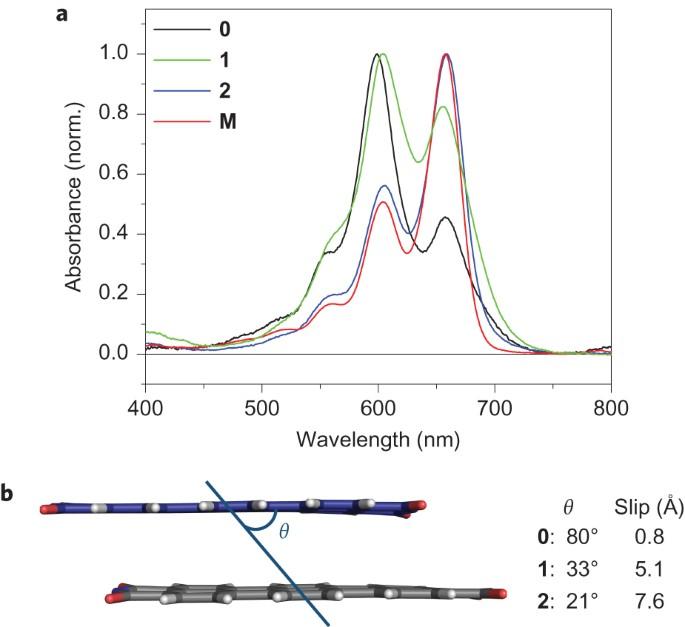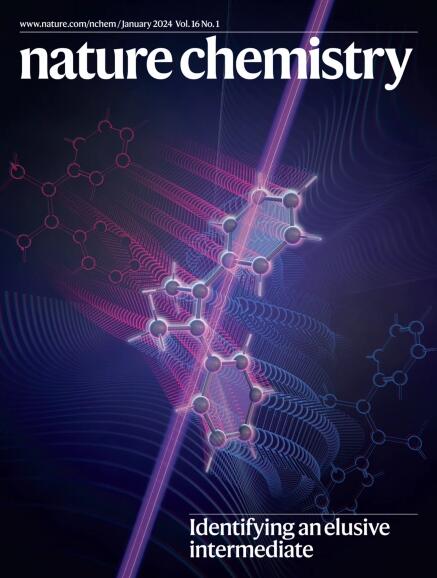通过控制π堆叠共价三烯二亚胺二聚体的分子内电荷转移实现单子裂变
IF 19.2
1区 化学
Q1 CHEMISTRY, MULTIDISCIPLINARY
引用次数: 220
摘要
当两个或两个以上分子的集合体吸收光子形成单色激子,并且能量和分子间相互作用有利时,单色激子可通过单色裂变迅速自发地产生两个三色激子。了解这一过程非常重要,因为它可能被证明对提高太阳能电池性能具有重要的技术意义。理论强烈建议电荷转移态参与单重子裂变,但它们的作用仍然是一个引人入胜的谜题,而且到目前为止,还没有任何分子体系为这种状态提供明确的证据。在这里,我们描述了一种萜烯二亚胺二聚体,它在极性溶剂中可在几皮秒内形成电荷转移态,并在非极性溶剂中同样快速、高产地发生单线裂变。这些结果表明,调整电荷转移态的能量与激子态的能量,可以抑制或促进单子裂变。分子发色团集合体中的单子裂变为提高太阳能电池效率提供了一条前景广阔的途径,但其机理尚未完全明了。现在,我们研究了一系列共价结合的π堆叠萜烯二亚胺二聚体,以阐明发色团之间的电荷转移态在单线裂变机制中的作用。本文章由计算机程序翻译,如有差异,请以英文原文为准。

Enabling singlet fission by controlling intramolecular charge transfer in π-stacked covalent terrylenediimide dimers
When an assembly of two or more molecules absorbs a photon to form a singlet exciton, and the energetics and intermolecular interactions are favourable, the singlet exciton can rapidly and spontaneously produce two triplet excitons by singlet fission. To understand this process is important because it may prove to be technologically significant for enhancing solar-cell performance. Theory strongly suggests that charge-transfer states are involved in singlet fission, but their role has remained an intriguing puzzle and, up until now, no molecular system has provided clear evidence for such a state. Here we describe a terrylenediimide dimer that forms a charge-transfer state in a few picoseconds in polar solvents, and undergoes equally rapid, high-yield singlet fission in nonpolar solvents. These results show that adjusting the charge-transfer-state energy relative to those of the exciton states can serve to either inhibit or promote singlet fission. Singlet fission in assemblies of molecular chromophores offers a promising route to improving solar cell efficiencies, but its mechanism is not fully understood. Now, a series of covalently bound π-stacked terrylenediimide dimers have been studied to elucidate the role of interchromophore charge-transfer states in the mechanism of singlet fission.
求助全文
通过发布文献求助,成功后即可免费获取论文全文。
去求助
来源期刊

Nature chemistry
化学-化学综合
CiteScore
29.60
自引率
1.40%
发文量
226
审稿时长
1.7 months
期刊介绍:
Nature Chemistry is a monthly journal that publishes groundbreaking and significant research in all areas of chemistry. It covers traditional subjects such as analytical, inorganic, organic, and physical chemistry, as well as a wide range of other topics including catalysis, computational and theoretical chemistry, and environmental chemistry.
The journal also features interdisciplinary research at the interface of chemistry with biology, materials science, nanotechnology, and physics. Manuscripts detailing such multidisciplinary work are encouraged, as long as the central theme pertains to chemistry.
Aside from primary research, Nature Chemistry publishes review articles, news and views, research highlights from other journals, commentaries, book reviews, correspondence, and analysis of the broader chemical landscape. It also addresses crucial issues related to education, funding, policy, intellectual property, and the societal impact of chemistry.
Nature Chemistry is dedicated to ensuring the highest standards of original research through a fair and rigorous review process. It offers authors maximum visibility for their papers, access to a broad readership, exceptional copy editing and production standards, rapid publication, and independence from academic societies and other vested interests.
Overall, Nature Chemistry aims to be the authoritative voice of the global chemical community.
 求助内容:
求助内容: 应助结果提醒方式:
应助结果提醒方式:


